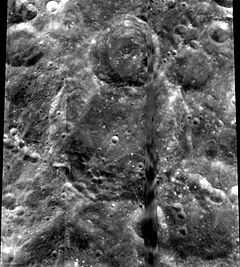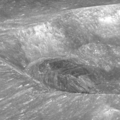Larmor (crater)
This article includes a list of references, related reading, or external links, but its sources remain unclear because it lacks inline citations. (October 2019) |
 LRO image, with Larmor Z at top | |
| Coordinates | 32°06′N 179°42′E / 32.1°N 179.7°E |
|---|---|
| Diameter | 97 km |
| Depth | Unknown |
| Colongitude | 180° at sunrise |
| Eponym | Joseph Larmor |



Larmor is a crater on the Moon's far side. It is located to the east-southeast of Shayn and due north of Dante. It is named in honor of the physicist Joseph Larmor.
The rim of Larmor is broken across by the satellite crater Larmor Z. The remaining rim is slightly worn, particularly to the southwest, and the inner wall is somewhat wider at the southern end. The wider southern inner wall displays terrace structures. Near the midpoint of the otherwise relatively level interior floor are some low hill features.
The satellite crater Larmor Q, located about one and a half crater diameters to the southwest of Larmor, lies at the center of a ray system. These rays lie primarily within cones to the north and southeast, which a 120° arc to the west is free of ray material.
Satellite craters
By convention these features are identified on lunar maps by placing the letter on the side of the crater midpoint that is closest to Larmor.
| Larmor | Latitude | Longitude | Diameter |
|---|---|---|---|
| K | 30.3° N | 179.0° W | 24 km |
| Q | 28.6° N | 176.2° E | 22 km |
| W | 33.3° N | 177.6° E | 27 km |
| Z | 33.7° N | 179.8° W | 49 km |
-
Oblique view of part of Larmor Q crater
References
- Andersson, L. E.; Whitaker, E. A. (1982). NASA Catalogue of Lunar Nomenclature. NASA RP-1097.
{{cite book}}: Invalid|ref=harv(help) - Blue, Jennifer (July 25, 2007). "Gazetteer of Planetary Nomenclature". USGS. Retrieved 2007-08-05.
{{cite web}}: Invalid|ref=harv(help) - Bussey, B.; Spudis, P. (2004). The Clementine Atlas of the Moon. New York: Cambridge University Press. ISBN 978-0-521-81528-4.
{{cite book}}: Invalid|ref=harv(help) - Cocks, Elijah E.; Cocks, Josiah C. (1995). Who's Who on the Moon: A Biographical Dictionary of Lunar Nomenclature. Tudor Publishers. ISBN 978-0-936389-27-1.
{{cite book}}: Invalid|ref=harv(help) - McDowell, Jonathan (July 15, 2007). "Lunar Nomenclature". Jonathan's Space Report. Retrieved 2007-10-24.
{{cite web}}: Invalid|ref=harv(help) - Menzel, D. H.; Minnaert, M.; Levin, B.; Dollfus, A.; Bell, B. (1971). "Report on Lunar Nomenclature by the Working Group of Commission 17 of the IAU". Space Science Reviews. 12 (2): 136–186. Bibcode:1971SSRv...12..136M. doi:10.1007/BF00171763.
{{cite journal}}: Invalid|ref=harv(help) - Moore, Patrick (2001). On the Moon. Sterling Publishing Co. ISBN 978-0-304-35469-6.
{{cite book}}: Invalid|ref=harv(help) - Price, Fred W. (1988). The Moon Observer's Handbook. Cambridge University Press. ISBN 978-0-521-33500-3.
{{cite book}}: Invalid|ref=harv(help) - Rükl, Antonín (1990). Atlas of the Moon. Kalmbach Books. ISBN 978-0-913135-17-4.
{{cite book}}: Invalid|ref=harv(help) - Webb, Rev. T. W. (1962). Celestial Objects for Common Telescopes (6th revised ed.). Dover. ISBN 978-0-486-20917-3.
{{cite book}}: Invalid|ref=harv(help) - Whitaker, Ewen A. (1999). Mapping and Naming the Moon. Cambridge University Press. ISBN 978-0-521-62248-6.
{{cite book}}: Invalid|ref=harv(help) - Wlasuk, Peter T. (2000). Observing the Moon. Springer. ISBN 978-1-85233-193-1.
{{cite book}}: Invalid|ref=harv(help)

